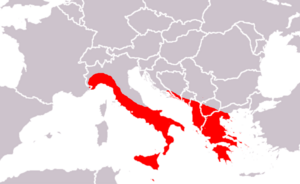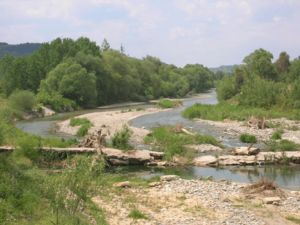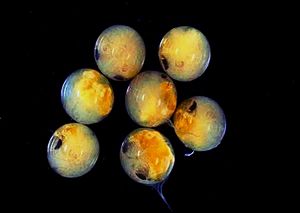Potamon fluviatile facts for kids
Quick facts for kids Potamon fluviatile |
|
|---|---|
 |
|
| Conservation status | |
| Scientific classification | |
| Genus: |
Potamon
|
| Species: |
fluviatile
|
 |
|
| Synonyms | |
|
|
The Potamon fluviatile, also known as the freshwater crab, is a type of crab that lives in fresh water. You can find it in or near streams, rivers, and lakes in Southern Europe. These crabs are omnivores, meaning they eat both plants and animals.
Adult freshwater crabs usually grow to about 50 mm (2 inches) across their shell. They can live for 10 to 12 years. They often live in burrows they dig themselves. These crabs can be quite aggressive and sometimes compete with native crayfish for food and space.
People have caught and eaten P. fluviatile for a very long time, even since ancient times. Today, too much fishing is a threat to them. Crabs living on islands are especially at risk. The Maltese freshwater crab, a special type of this crab, has become a symbol for protecting nature in Malta. There's even a group of these crabs in Rome that might have been brought there thousands of years ago!
Contents
What Does It Look Like?
Adult Potamon fluviatile crabs can have a carapace (the main body shell) up to 50 mm (2 inches) long. Female crabs are usually a bit smaller than males. Like other crabs, their body is roughly square-shaped. Their small abdomen (tail part) is tucked underneath their main body.
They have five pairs of legs. The first pair has large claws, which they use for defense and catching food.
Life Cycle and Reproduction
The freshwater crab typically lives for 10 to 12 years. They do not shed their shells (moult) during winter. Mating can last for a long time, from 30 minutes to 21 hours!
Females usually lay their eggs in August. They carry the eggs on special appendages under their abdomen. The baby crabs develop fully inside the eggs. They hatch directly into tiny crabs, skipping the larval stages that many other crabs have.
Potamon fluviatile crabs are safe to eat. In fact, their old scientific name, edulis, means "edible." Ancient Greeks knew about these crabs. They even showed them on medals found in Agrigento, Sicily. More recently, this crab was featured on the 5-cent coin in Malta before the Euro was introduced in 2007.
How They Live (Ecology)
Potamon fluviatile crabs eat many different things. They are not picky eaters! They munch on plant bits, scrape algae off surfaces, and hunt smaller animals. Their prey includes frogs, tadpoles, and various invertebrates. This can include insect larvae, snails, or worms.
No single animal hunts only P. fluviatile. However, many animals will eat them if they get a chance. These include rats, foxes, weasels, birds of prey, and jays. Humans are probably their biggest predators. Some people can catch thousands of crabs in just one season!
Adult crabs live in burrows they dig. Smaller crabs hide under stones for safety. The entrances to their burrows can be far from the water, sometimes more than 5 m (16 ft) away. The burrows are always above the water level. These tunnels can be over 80 cm (31 inches) long. They likely help protect the crabs from very cold weather.
These crabs are known to be aggressive. They mostly attack using their larger right claw. This is because about 90% of them are "right-handed."
In the Apennine Mountains in Italy, P. fluviatile crabs are only found on the southern side. This is different from the crayfish Austropotamobius pallipes, which lives on both sides. Even though their living areas overlap, these two species usually don't live in the same exact streams. It seems the crab is better at competing for resources. This forces the crayfish to live in less ideal places where the crab cannot survive.
New types of crayfish that are not native to the area might be a bigger threat to P. fluviatile than native ones. However, the biggest dangers to these crabs are still pollution, too much fishing, and the drying up of wetlands.
Where They Live (Distribution)

The natural areas where Potamon fluviatile lives are very spread out and broken up. They cover parts of many countries along the Mediterranean Sea. You can find them in mainland Italy and on the Balkan Peninsula. This includes areas from Dalmatia to the Axios River in Greece.
They also live on several islands. These include Sicily, Malta and Gozo, the Ionian Islands, Aegean Islands, Sporades, and Andros in the Cyclades. While the species is widespread, its numbers are decreasing. The groups living on islands are especially vulnerable.
Italy
Potamon fluviatile is found in many parts of mainland Italy. This includes areas like Trento, Lombardy, Veneto, Liguria, Tuscany, Umbria, Lazio, Campania, Apulia, and Calabria. They also live on the island of Sicily. They used to be found as far north as Lake Garda, but now they don't live north of the River Po.
In 1997, a group of P. fluviatile crabs was found under the old ruins of Trajan's Forum in the middle of Rome. They were living in canals built by the Etruscans that connect to the Cloaca Maxima (an ancient sewer system). Scientists studied their DNA. They found that these crabs were similar to those in Greece. Researchers believe the Greeks might have brought them to Rome even before the city was founded, about 3000 years ago. These crabs are unusually large, up to 12 cm (4.7 inches), and live a long time (up to 15 years). This also suggests they have been living there for a very long time.
Malta
On the island of Malta, Potamon fluviatile is rare. It is found in only a few places in the western part of the island. On Gozo, there is only one group of these crabs. They live in a valley that is only about 700 m (765 yd) long.
Balkans
In the Balkan Peninsula, Potamon fluviatile lives in Croatia, Montenegro, North Macedonia, Albania, and Greece. There are four species of Potamon crabs in the Balkans. P. fluviatile is replaced by Potamon ibericum in northeastern Greece. In mainland Greece, P. fluviatile is found in the rivers like the Axios, Thyamis, Aheron, Arachthos, Pineiós, Piros-Tethreas, Pamisos, and Evrotas.
In the Ionian Islands, P. fluviatile is known to be in only one spot on Corfu. It is also found on Kefalonia, Lefkada, and Zakynthos. In the Aegean Islands, you can find it on Skiathos and Skopelos (Sporades), on Euboea and Skyros, and in one place on Andros in the Cyclades.
Crab Family and Types (Taxonomy)
Potamon fluviatile lives at the western edge of where the Potamon group of crabs can be found. Other species in this group live across Eastern Europe, the Middle East, and Central Asia, reaching as far east as northwestern India.
Some scientists think that the P. fluviatile crabs living on the Peloponnese, Kefalonia, and Zakynthos might be a different, hidden species. For example, the group from the Peloponnese was named P. pelops in 2010.
P. fluviatile used to be divided into three subspecies. Two of these lived in North Africa. Later, they were combined and separated from P. fluviatile to become their own species, Potamon algeriense.
In 1990, the crabs on Malta were described as a separate subspecies, Potamon fluviatile lanfrancoi. This specific type of crab has become a symbol for protecting nature in Malta. It was legally protected in 1993. However, not all scientists agree that it should be considered a separate subspecies.



